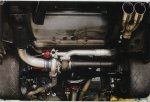Here is what the FAQ says, they claim to address these issues:
If water hits the hot turbo, will it crack?
Seems like it might when you first think about it, however, when I asked the Garrett engineers this questions they just laughed. There is a big difference in water splashing on a hot turbo and submerging it in enough water and fast enough to really cool it down fast. Both the new turbocharged Vette systems and the new Porsche systems sit the turbo down low and exposed to water and anything else that goes under a car.
Plus, our turbos just don't get that hot and when weather conditions are such that there is a lot of water around, you can't push enough boost to get the turbo hot anyway because you'd just spin the tires.
With the turbo so far back, don't you get a lot of turbo lag?
No, our turbochargers are sized to operate at this remote location. Just like any turbocharger, once the turbo is up to temperature and in the rpm range for which it was designed to operate. The boost comes on hard and fast. All of our systems will produce full boost below 3000 rpm.
If you were to take a conventional turbo and place it at the rear, you would have lots of lag and consequently, our turbo wouldn't work properly if mounted up front.
With so long of intake and exhaust tubes, doesn't it take a while for the boost to build up?
No, our intake tubing volume is about the same as most conventional turbo setups that are running a front mounted intercooler, and less than many of them that run large intercoolers. We aren't talking about a small compressor filling up a large air tank, we are talking about a huge compressor filling up a very small volume which only takes a fraction of a second. Our systems compress the intake tubing in about .05 seconds. So much for turbo lag...
Doesn't water get into your engine with the filter mounted down low?
No, even under very wet conditions the filter sheds most all water. Every kit includes a K&N PreCharger which is a "sock" that protects the filter under very dusty or wet conditions. The only thing you don't want to do is completely submerge the filter. This would draw water through the filter and into the intake tubing. For most vehicles that would mean you would have water coming in your doors before you'd have a problem with the turbo's air filter.
Claimed benefits:
Benefits of Remote Mounting
* Ease of installation. STS turbo systems can be installed in 4-6 hours with standard tools and average mechanical ability.
* Performance Sound. The turbo acts as a muffler and sounds like an aftermarket performance muffler. Turbo spool and rushing air from the blow-off valve make a unique sound that will turn heads!
* No need for major modifications to your vehicle. STS systems are designed to bolt on using factory mounts without cutting or modifying your vehicle.
* Increased gas mileage. Unlike a belt driven supercharger, the turbo utilizes "wasted" energy leaving your tailpipe. Most of our customers get 2-4 mpg increase in gas mileage.
* Lower underhood temperatures. No need to worry about melting wires, hoses, or other components.
* Easily converts back to stock in less than an hour.
* More room under the hood. Future repair work or modifications will not require the expense of removing the turbo system to allow access to any of the engine components.
* Cooler oil to the turbo. Cool oil is better for both the turbo and engine.
* Approximately 500F lower turbo temperatures. Eliminates the need for a turbo-timer, which allows the engine to run after the car is shut off in order to cool down the turbo and prevent oil and bearing damage.
* Denser exhaust gasses drive the turbo turbine wheel more efficiently.
* Built-in intercooling. Intake piping provides ~50% intercooler efficiency. There is no need for the expense, pressure drop, and installation problems associated with a front mounted intercooler.
* Turbo is exposed to ambient air rather than underhood air. Allows for better cooling of turbo components.
* No need for expensive headers, mufflers, or exhaust systems.
* Turbo is closer to the tail pipe outlet. Provides a better pressure differential across the turbine wheel which promotes better flow across turbine.
* Better weight transfer. Increases traction because the bulk of system is mounted in rear of vehicle rather than up front.
* Less noise in the passenger compartment.
* Quieter wastegates, especially if vented to atmosphere.
* Better engine cooling capacity.


